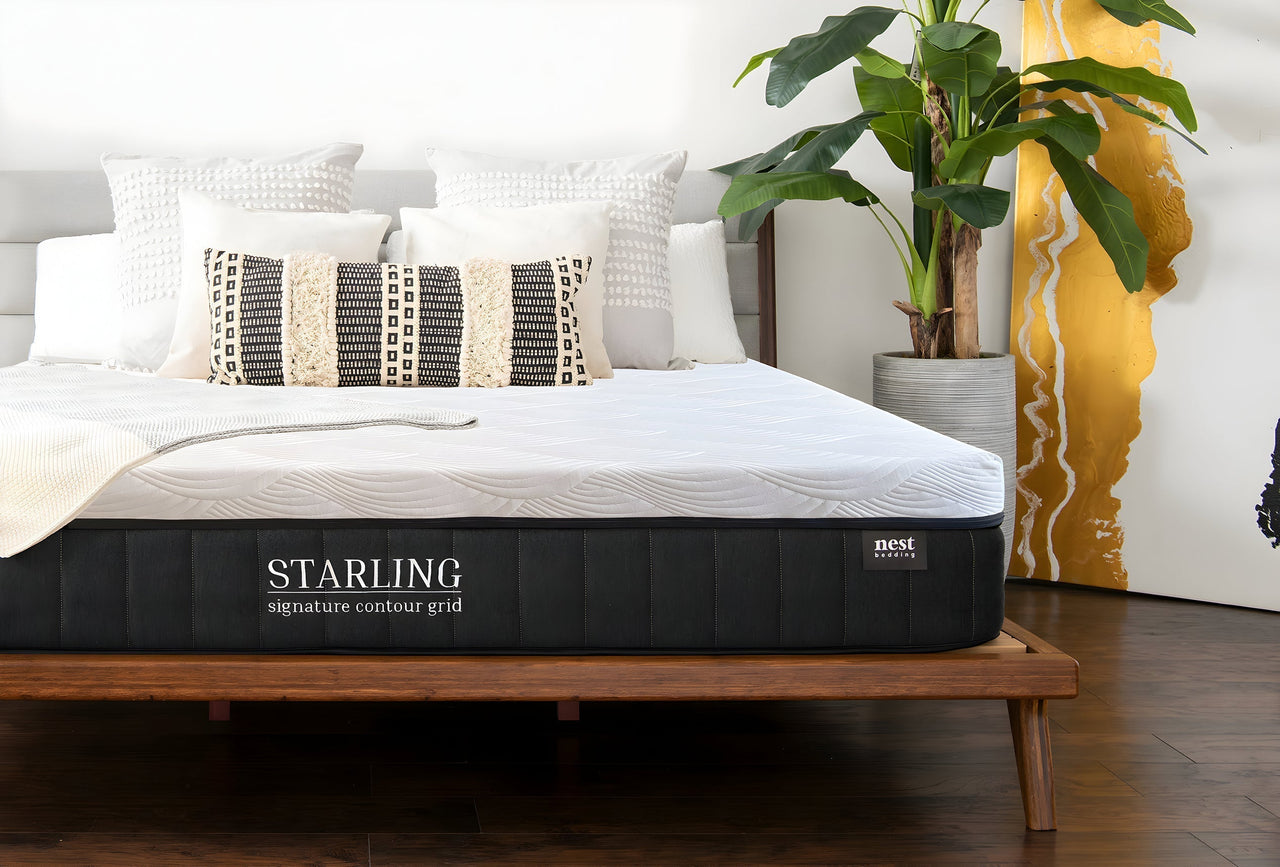The Complete Guide to Mattress Sizes: Finding Your Perfect Fit

Picking the right mattress size is a big deal when putting together your perfect bedroom. A mattress that fits properly in your space while meeting your sleep needs can make the difference between restful nights and cramped discomfort.
Whether you're moving into your first apartment, upgrading your current sleeping situation, or furnishing a guest room, understanding mattress dimensions and how they relate to your available space will help you make an informed choice. This comprehensive guide will walk you through everything you need to know about mattress sizes, from standard dimensions to room requirements, helping you select the perfect size for your specific situation.
Understanding Standard Mattress Dimensions
Each mattress size serves different needs and fits different spaces. Let's examine each standard size in detail:
Twin Mattress (38" x 75")
Twin mattresses work well in children's rooms and smaller spaces. At just over 3 feet wide and 6 feet long, they provide adequate space for a single sleeper while taking up minimal floor space. Twin mattresses need a minimum room size of 7 x 9 feet, though 8 x 10 feet allows for more comfortable movement around the bed. These mattresses make perfect sense for kids' rooms, dorm rooms, or guest rooms where space comes at a premium. Nest Bedding’s Quail Responsive Foam Mattress is the most affordable all-foam option online with a perfect balance of comfort, breathability, and support.
Twin XL Mattress (38" x 80")
The Twin XL adds 5 inches of length to the standard twin size, making it ideal for taller individuals who need extra legroom. This size maintains the same width as a twin but provides additional length that accommodates people up to 6'2" comfortably. Twin XL mattresses require a minimum room size of 7 x 10 feet. Nest Bedding's The Finch Natural Latex Mattress in Twin XL size offers an excellent option for taller individuals seeking an eco-friendly sleep solution.
Full/Double Mattress (54" x 75")
Full mattresses provide additional width compared to twin sizes, offering 16 more inches of space across. This size works well for single adults who want more room to move or couples who don't mind sleeping close together. A full mattress needs a minimum room size of 9 x 10 feet, though 10 x 12 feet provides more comfort. The Nest Bedding Sparrow Signature Hybrid Mattress in full size offers couples a comfortable option with premium materials and multiple firmness levels.
Queen Mattress (60" x 80")
Queen mattresses represent the most popular size for couples, providing a good balance between personal space and room efficiency. At 60 inches wide and 80 inches long, queen mattresses give each person about 30 inches of personal space. These mattresses require a minimum room size of 10 x 10 feet, but 10 x 14 feet allows for better furniture placement and movement. Nest Bedding's Owl Natural Latex Hybrid in queen size provides couples with a luxurious sleep experience while maintaining reasonable space requirements.
King Mattress (76" x 80")
King mattresses offer maximum width for couples who prioritize personal space. At 76 inches wide, each person gets about 38 inches of sleeping space - equivalent to a twin bed. These mattresses need larger rooms, with a minimum size of 12 x 12 feet, though 13 x 13 feet or larger works better. The Nest Bedding Sparrow Signature Hybrid in king size provides couples with ample space and premium comfort.
California King Mattress (72" x 84")
California king mattresses trade some width for extra length compared to standard kings. At 84 inches long, they accommodate very tall individuals comfortably. These mattresses require similar room dimensions to standard kings but work particularly well in longer, narrower rooms.
The Starling Signature Contour Grid Mattress in California king offers adaptive support for a customized sleep experience.
Nest's Sparrow, Owl, and Finch mattresses in both king and California king sizes feature dual firmness, so each partner can choose their preferred level of support.
How to Choose the Right Mattress Size
Consider Your Sleep Situation
Single sleepers can usually sleep comfortably on twin, twin XL, or full mattresses, depending on their size preferences and available space. Couples typically need at least a queen size, though many prefer king sizes for additional personal space. The Nest Bedding collection offers options in all sizes to accommodate different sleep situations.
Measure Your Room
Before selecting a mattress size, measure your bedroom carefully. Include space for:
- Walking paths around the bed (at least 2 feet on each side)
- Door clearance
- Furniture placement
- Window access
- Closet door movement
Account for Additional Furniture
Consider how other bedroom furniture will fit with different mattress sizes:
- Nightstands (typically 20-30 inches wide each)
- Dressers (usually 30-72 inches wide)
- Desks or seating areas
- Storage pieces
Special Considerations for Different Living Situations
Small Apartments
In small apartments, consider space-saving options like:
- Twin XL mattresses for single sleepers
- Murphy beds with full-size mattresses
- Platform beds with storage underneath
- Minimal additional furniture
Master Bedrooms
Master bedrooms typically accommodate larger mattresses well:
- Queen size works well in standard master bedrooms
- King size fits comfortably in larger master suites
- California king suits very long rooms
Guest Rooms
Guest rooms often work best with versatile sizes:
- Full size accommodates couples while saving space
- Queen size provides comfort without overwhelming the room
- Twin beds offer flexibility for different guest configurations
- Mattress Size Impact on Sleep Quality
Personal Space Requirements
Different sleepers need different amounts of space:
- Side sleepers typically need more width for comfortable arm positioning; The Starling Signature Contour Grid Mattress is engineered with side sleepers in mind
- Back sleepers can manage with less width; The Raven Flippable Hybrid Mattress is ideal for back sleepers
- Combination sleepers benefit from additional space to move; Nest Bedding's Owl Natural Latex Hybrid caters to all sleep positions
Temperature Considerations
Mattress size can affect sleep temperature:
- Larger mattresses provide more space for heat dissipation
- Couples on smaller mattresses may experience more heat buildup
- Nest Bedding's temperature-regulating materials, such as Energex™ Temperature Responsive Foam in the Sparrow Signature Hybrid and Quail Responsive Foam Mattress help manage heat regardless of size
Movement Transfer
Bigger mattresses can reduce sleep disruption:
- More space means less partner movement disturbance
- King sizes allow almost complete movement isolation
- Quality materials like those used in Nest Bedding mattresses help minimize motion transfer
The Nest Bedding Sparrow Signature Hybrid, Owl Natural Latex Hybrid, and Quail Responsive Foam Mattress, in particular, absorb the “bounce” caused by movement.
Making the Final Decision
Budget Considerations
Remember that larger mattresses cost more:
- Initial purchase price increases with size
- Bedding costs more for larger sizes
Long-term Planning
Think about future needs:
- Relationship status changes
- Room changes or moves
- Growing children
- Aging considerations
Conclusion
Choosing the right mattress size requires careful consideration of multiple factors, from room dimensions to personal sleep preferences. Take accurate measurements of your space, consider your current and future needs, and factor in your budget when making your decision. Remember that quality matters as much as size - consider premium options like those offered by Nest Bedding to ensure both proper fit and optimal comfort.
Whether you choose a space-saving twin XL or a spacious king, the right size combined with the right mattress will help you create your ideal sleep environment.




